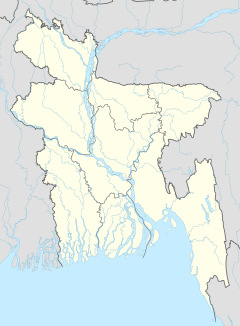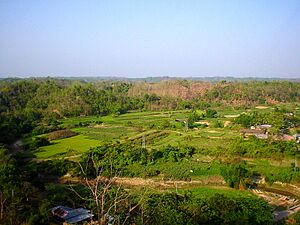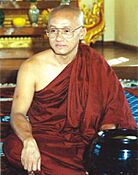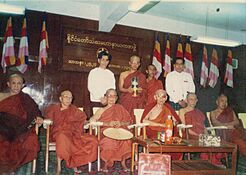Buddha Dhatu Jadi facts for kids
Quick facts for kids Buddha Dhatu JadiBandarban Golden Temple |
|
|---|---|
|
বুদ্ধ ধাতু জাদি
|
|
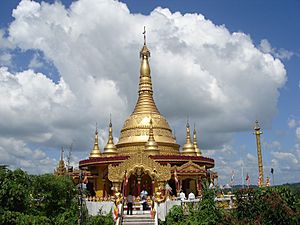 |
|
| Religion | |
| Affiliation | Buddhism Buddhist Temple |
| Sect | Theravada Buddhism |
| District | Bandarban |
| Region | Chittagong |
| Deity | Buddha |
| Festival | Maha Pabbajja |
| Status | Active |
| Location | |
| Location | Pulpara, Balaghata, Bandarban |
| Country | Bangladesh |
| Architecture | |
| Founder | U Pannya Jota Mahathera |
| Date established | December 25, 1995 |
| Completed | February 5, 2000 |
| Height (max) | 60 ft (18 m) |
The Buddha Dhatu Jadi (Bengali: বুদ্ধ ধাতু জাদি), also known as the Bandarban Golden Temple, is a famous Buddhist temple in Bangladesh. It's located near Balaghata town in Bandarban City. The word Dhatu means the remains of a holy person. In this temple, you'll find relics that belonged to Buddha himself!
This temple is the biggest Theravada Buddhist temple in Bangladesh. It also has the second-largest Buddha statue in the whole country. The Bandarban Golden Temple follows the Theravada Buddhism style, which is practiced by the Marma people. They are a main ethnic group living in Bandarban. The temple was built in 2000, and its design is inspired by Arakanese architecture from South East Asia.
Contents
Where is the Golden Temple?
Locally, this Buddhist temple is called Kyang. It's found in the Bandarban Hill District in southeastern Bangladesh. This area is part of the Chittagong Division and the Chittagong Hill Tracts.
The temple sits on top of a hill in Bandarban, a town surrounded by rolling hills and thick forests. Two of the highest peaks in the area are Tajingdong and Keokeradong. The Sangu river flows through the town, and there's even a waterfall nearby! The temple itself is built on a hill about 60 meters (200 feet) high. It's about 4 kilometers (2.5 miles) from Balaghat town and 10 kilometers (6 miles) from Bandarban city.
Who built the temple?
Bandarban has many Buddhists. While Bangladesh is mostly a Muslim country, Buddhism is the third-largest religion here. Most Buddhists live in the southeastern areas like Chittagong and the Chittagong Hill Tracts. They mostly practice Theravada Buddhism.
The Marma are an important group in this region. They are from Arakanese descent and are Buddhists. They are the second-largest local group in the hill districts of Bangladesh.
The founder and main priest of the Buddha Dhatu Jadi temple is Ven. U Pannya Jota Mahathera. He comes from the royal Bohmong family of Bandarban. He became a Theravada monk in 1991. Before that, he worked for the government of Bangladesh as a senior assistant judge for eight years. The special Buddha's dhatu (relic) kept in the temple was a gift to Ven. U Pannya Jota Mahathera in 1994. It was given by the State Sangha Maha Nayaka Committee from Myanmar.
What does the temple look like?
You reach the temple by walking up an elegant stairway. This impressive temple, built on the hilltop, is decorated with beautiful sculptures. Inside, you'll find the second-biggest statue of the Buddha in Bangladesh. There are also smaller statues and a golden bell shaped like a dragon.
Building the temple started in 1995 and finished in 2000. The dhatu, which are the actual remains of Buddha, are placed under four Buddha statues here. Buddhists believe that having these relics brings peace and happiness. This temple is now part of a special "Buddhist Circuit Tour" that helps promote tourism in the region.
When you visit the temple, remember there's a strict dress code. You should not wear shorts or shoes inside the temple grounds.
Images for kids
See also
 In Spanish: Buddha Dhatu Jadi para niños
In Spanish: Buddha Dhatu Jadi para niños


